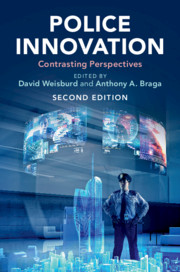Book contents
- Police Innovation
- Police Innovation
- Copyright page
- Contents
- Figures
- Tables
- Notes on Contributors
- Introduction
- Part I Community Policing
- Part II Procedural Justice Policing
- Part III Broken Windows Policing
- Part IV Problem–Oriented Policing
- Part V Pulling Levers (Focused Deterrence) Policing
- Part VI Third–Party Policing
- Part VII Hot Spots Policing
- Part VIII Predictive Policing
- Part IX CompStat
- Part X Evidence-Based/ Risk-Focused Policing
- Part XI Technology Policing
- Index
- References
Part I - Community Policing
Published online by Cambridge University Press: 09 August 2019
- Police Innovation
- Police Innovation
- Copyright page
- Contents
- Figures
- Tables
- Notes on Contributors
- Introduction
- Part I Community Policing
- Part II Procedural Justice Policing
- Part III Broken Windows Policing
- Part IV Problem–Oriented Policing
- Part V Pulling Levers (Focused Deterrence) Policing
- Part VI Third–Party Policing
- Part VII Hot Spots Policing
- Part VIII Predictive Policing
- Part IX CompStat
- Part X Evidence-Based/ Risk-Focused Policing
- Part XI Technology Policing
- Index
- References
Summary
The concept of community policing is very popular with politicians and the general public – so popular that few police chiefs want to be caught without some program they can call community policing. As early as 1997, a survey of police departments conducted by the Police Foundation found that 85 percent reported they had adopted community policing or were in the process of doing so (Skogan, 2005). The biggest reason they gave for not doing so was that community policing was “impractical” for their community. In my own tabulations of the data, this reply was mostly from small departments with only a few officers. Bigger cities included in the survey (those with populations greater than 100,000) all claimed to have adopted community policing – half (they recalled) by 1991 and the other half between 1992 and 1997. The most recent similar figures come from a national survey of departments conducted in 2013. In my tabulations, about 95 percent of the departments in cities of more than 250,000 in population that had an official mission statement included a commitment to community policing (Bureau of Justice Statistics, 2015).
- Type
- Chapter
- Information
- Police InnovationContrasting Perspectives, pp. 25 - 68Publisher: Cambridge University PressPrint publication year: 2019



